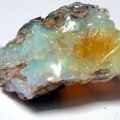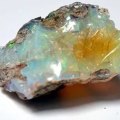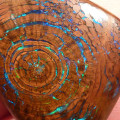As with all gemstones, larger opals are more valuable simply because there is literally more material to work with. This concept is not exclusive to opals either. The value of an opal depends on many factors. The type of opal, the tone of the body, the brightness, the pattern, the thickness of the color bar, the play of colors and the faults play an important role in determining the value.
Opal is a rare gemstone because its formation requires a very specific environment. Opal is worth a lot because of its unique phenomenon of play of colors, which cannot be observed in any other gemstone. Opal is very expensive because each stone has its own unique pattern. There are no two similar opals.
How is opal weird? Silica is one of the most common minerals on the planet, but precious opal is very rare, much rarer than diamonds. Precious opal is rare because the natural processes that create it rarely occur. Solid opal that is translucent to opaque when viewed from above and that has a play of colors against a dark gray background that is classified as semi-black on the Lightning Ridge Miners Association tone scale. An opal can contain any or all of these colors, arranged in wonderful patterns with names such as harlequin, pin fire, Chinese writing, flower garden, mackerel sky, slab and rolling flash.
This compares to the blackness scale shown below. Stones that reach values of N1 to N4 on this scale are considered to be black opals, which attracts the additional value associated with this class of opal.
Opal stone
is mainly found in Australia, where mines supply almost every opal in the world. The pattern of colored segments that form the play of colors of a precious opal is unique to each individual opal.These are not associated with the descriptive nomenclature of natural opals, but have been included to complete the nomenclature. In modern times at Lightning Ridge, opal mining gave Aboriginal people the opportunity to earn a decent living in a time when it was very difficult anywhere else. The term crystal opal refers to the “diaphanity” (transparency) of an opal, not its crystal structure, and is defined as any type of opal that is translucent or transparent. The adjective solid has been removed from opal jargon for the simple reason that, from a scientific point of view, all varieties of opal are solid.
Australian boulder opal is something beautiful to behold, its variety of colors changes depending on the angle from which you look. To determine the body tone of an opal, the opal piece is examined, “face up”, and its position on the body tone scale is determined (by visual comparison). Coober Pedy is the main producer of precious white opal, which is predominantly seen in overseas stores, particularly in the United States. The type of opal, the tone of the body, the brightness, the pattern, the thickness of the color bar, the play of colors and faults play an important role in determining the value.
Australian vernacular names for opal and phrases that have been part of the Australian landscape for hundreds of years have contributed to the mystery and mythology of the daily language used in opal mining fields. Usually, opals with a black or dark body tone are more valuable than those with a white, light or crystalline body tone, because a stone with a darker body tone tends to display colors more vibrantly.








